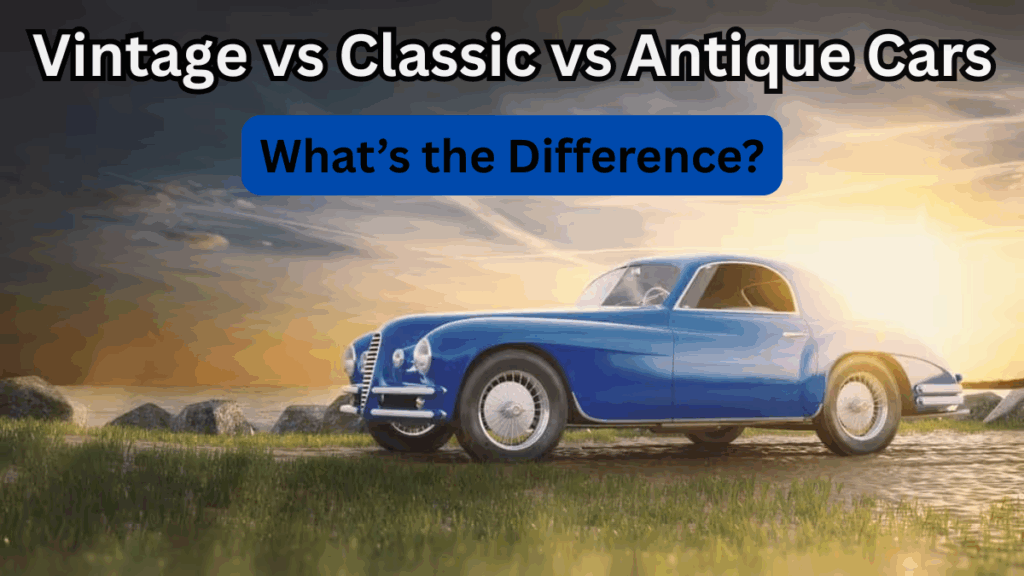Ever found yourself admiring an old car and wondering if it’s vintage, classic, or antique? You’re not alone. Car lovers, collectors, and even casual drivers often mix up these terms—but each one has its own distinct meaning.
Whether you’re diving into the world of collectible automobiles or just want to brush up on historic vehicle terms, this guide will help you confidently identify the difference between vintage, classic, and antique cars.

Table of Contents
Understanding the Terms: A Car Classification Guide
Cars aren’t just defined by their age; they’re categorized by historical, stylistic, and cultural significance. Here’s a quick car classification guide to break down these popular terms:
Category |
Age Range |
Key Characteristics |
|---|---|---|
Antique |
45+ years old |
Often built before 1975; rare, preserved or restored vehicles; high historical value |
Vintage |
1919–1930 |
Post–WWI to pre–Great Depression era; distinct body styles, handcrafted details |
Classic |
20–40 years old |
Iconic design, performance-focused, nostalgic appeal, usually from 1980s–early 2000s |
Antique Cars: A Window to Automotive History
Antique cars are true relics. These are vehicles that were built at least 45 years ago—typically pre-1975. They’re not just old; they’re considered historically significant.
Common traits of antique cars:
-
Rare parts and craftsmanship
-
Often not driven daily
-
Displayed in museums or car shows
-
Require special restoration or preservation
Fun Fact: Some clubs and registries, like the Antique Automobile Club of America (AACA), consider only cars made before 1975 as antique.
Vintage Cars: Elegance from the Past
The word “vintage” is often used loosely, but it technically refers to vehicles made between 1919 and 1930. This was a golden era when automobile design transitioned from basic functionality to elegant form.
What makes a car vintage?
-
Handcrafted elements
-
Often rare and limited in number
-
Stylish coachwork and wood accents
-
Often seen in classic movies or collector auctions
Note: Not all old cars are vintage—only those from the post-WWI/pre-Depression era fit this category.
Classic Cars: Nostalgia on Wheels
Classic cars bring a nostalgic vibe. These are vehicles between 20 to 40 years old, and they’ve typically earned a place in history because of their iconic status, design, and performance.
Why do people love classic cars?
-
They’re easier to maintain than antiques
-
More likely to be roadworthy and driven regularly
-
Popular in restoration and modification communities
-
Recognized by car shows and clubs like the Classic Car Club of America (CCCA)
Think of the Ford Mustang, Chevy Camaro, or Porsche 911—all widely celebrated classic models.
Quick Recap: Spot the Difference at a Glance
Here’s a summary table to help you quickly identify the difference between vintage, classic, and antique cars:
Type |
Age |
Production Years |
Main Use |
|---|---|---|---|
Antique |
45+ years old |
Before 1975 |
Museums, collectors |
Vintage |
Around 100 years old |
1919–1930 |
Historical shows, high-end collectors |
Classic |
20–40 years old |
1980s–early 2000s |
Driving, restoration, shows |
Why Car Classification Matters
Understanding these historic vehicle terms isn’t just for fun—it helps:
-
Establish vehicle value and rarity
-
Comply with insurance and registration rules
-
Join car clubs and attend proper events
-
Make better restoration and purchasing decisions
If you’re a car collector, enthusiast, or investor, knowing these categories is an essential part of navigating the world of collectible cars.
Frequently Asked Questions (FAQs)
1. What qualifies a car as a classic?
A car is generally considered a classic if it’s between 20 and 40 years old, has historical interest, and retains most of its original features. Cars with cultural, design, or performance significance often fall into this category.
2. Are vintage and antique cars the same?
No. While both are old, vintage cars specifically refer to those made between 1919 and 1930, while antique cars are usually 45+ years old, often built before 1975.
3. Can I drive antique cars on public roads?
In most places, yes—though you’ll likely need special registration (such as “Historic Vehicle” plates) and may face restrictions on use, especially for daily driving.
4. How do I find out if my car is classic, vintage, or antique?
Refer to your car’s manufacturing year and compare it to the accepted definitions in this car classification guide. You can also consult organizations like the AACA or CCCA for official classification.
Final Thoughts
Whether you’re new to car collecting or simply fascinated by automotive history, knowing the difference between vintage, classic, and antique cars gives you a deeper appreciation for these timeless machines. Each car has a story, a style, and a legacy—and understanding these categories helps preserve that history for future generations.
Click here to learn more





